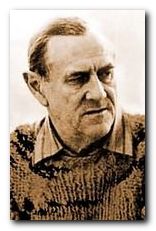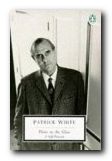 1912. Patrick White born in Sydney – his father was a wealthy sheep farmer. Both parents were indolent, snobbish, and never worked. White always felt very distant from them.
1912. Patrick White born in Sydney – his father was a wealthy sheep farmer. Both parents were indolent, snobbish, and never worked. White always felt very distant from them.
He was sent to England to be educated at a boarding school in Cheltenham College. He hated it, and reproached his parents:
“I resented their capacity for boring me and their dumping me in a prison of a school at the other side of the world.”
He spent adolescent holidays in Dieppe and Germany, and read mainly poetry as a youth, then went on to take a degree in French and German literature at Cambridge University.
1930s. His father finally made him an allowance of £400 per year, and he settled in bohemian London, making friends with the painters Francis Bacon and Roy de Maistre. He made a break with Australia which was part cultural, and partly to do with his struggle with sexual identity:
“I see myself not so much a homosexual as a mind possessed by the spirit of a man and woman according to actual situations or the characters I become in my writing.”
1939. Published his first novel, Happy Valley, which he later disowned. He emigrated to the USA, but returned on the outbreak of war to join the RAF. He served in the middle East in the Intelligence Corps, working as a censor.
“Superficially my war was a comfortable exercise in futility carried out in a grand hotel amongst the bridge players and swillers of easy-come-by whisky. My chest got me out of active service and into guilt, as I wrote two, or is it three of the novels for which I am now acclaimed.”
1941. Published his second novel, The Living and the Dead, about which he later said “Perhaps it should not have been written”.
1945. He settled back in Australia with his Greek partner Monoly Lascaris, and they attempted a form of self-sufficiency on a smallholding, making a living from selling flowers, vegetables, milk, and cream.
1948. Published The Aunt’s Story and traveled widely throughout England, France, Germany, Egypt, Palestine, and Greece, as well as Australia and the USA. His spiritual life is particularly tempestuous.
“Those who are doomed to become artists are seldom blessed with equanimity. They are tossed to drunken heights, only to be brought down into a sludge of headachy despair.”
1955. Published The Tree of Man – a family saga, which focused on ordinary people at the beginning of the twentieth century. Stan Parker is a young farmer. He establishes a family and farm in the Australian wilderness, has children and grandchildren, but the land is eventually engulfed by suburb.
1957. Published Voss “Much of Voss was written in bed”
1961. Published Riders in the Chariot.
1966. Published The Solid Mandala
 Flaws in the Glass (1981) is an amazingly frank self-portrait. In this he reveals the truths about his homosexuality; his feelings of inhabiting different personae and sexual identities; his lifelong feud with his mother; his alcoholism, and his later political radicalism. Reading it will certainly help you to understand his complex fictions, but more importantly it lays bare his relationship with Australia. White reveals a great deal about the psychological processes through which his experiences and ideas are transformed into art. It is a fascinating if at times almost uncomfortable reading experience.
Flaws in the Glass (1981) is an amazingly frank self-portrait. In this he reveals the truths about his homosexuality; his feelings of inhabiting different personae and sexual identities; his lifelong feud with his mother; his alcoholism, and his later political radicalism. Reading it will certainly help you to understand his complex fictions, but more importantly it lays bare his relationship with Australia. White reveals a great deal about the psychological processes through which his experiences and ideas are transformed into art. It is a fascinating if at times almost uncomfortable reading experience.
1970. Published The Vivesector.
1973. Published The Eye of the Storm. Awarded the Nobel Prize for Literature – but White, who guarded his privacy, did not attend the award ceremonies. He persuaded his friend, the artist Sidney Nolan, to accept it in Stockholm on his behalf.
1976. Published A Fringe of Leaves
“I first went to Fraser Island after Sydney Nolan gave me the story of Eliza Fraser and the wreck of the Stirling Castle. I went there on my own and began A Fringe of Leaves but gave up on deciding that Australian writers should deal with the twentieth century. Years later Manoly and I went to the island together and explored it more thoroughly. From two visits and a certain amount of necessary research, it became part of my life, and the novel I wrote as painful and sensual a situation as one I might have lived through personally whether as Ellen Roxburgh or Jack Chance.”
1979. Published The Twyborn Affair
1981. Published Flaws in the Glass
1986 Published Memoirs of Many in One
1990 Died, after a long illness.
© Roy Johnson 2005